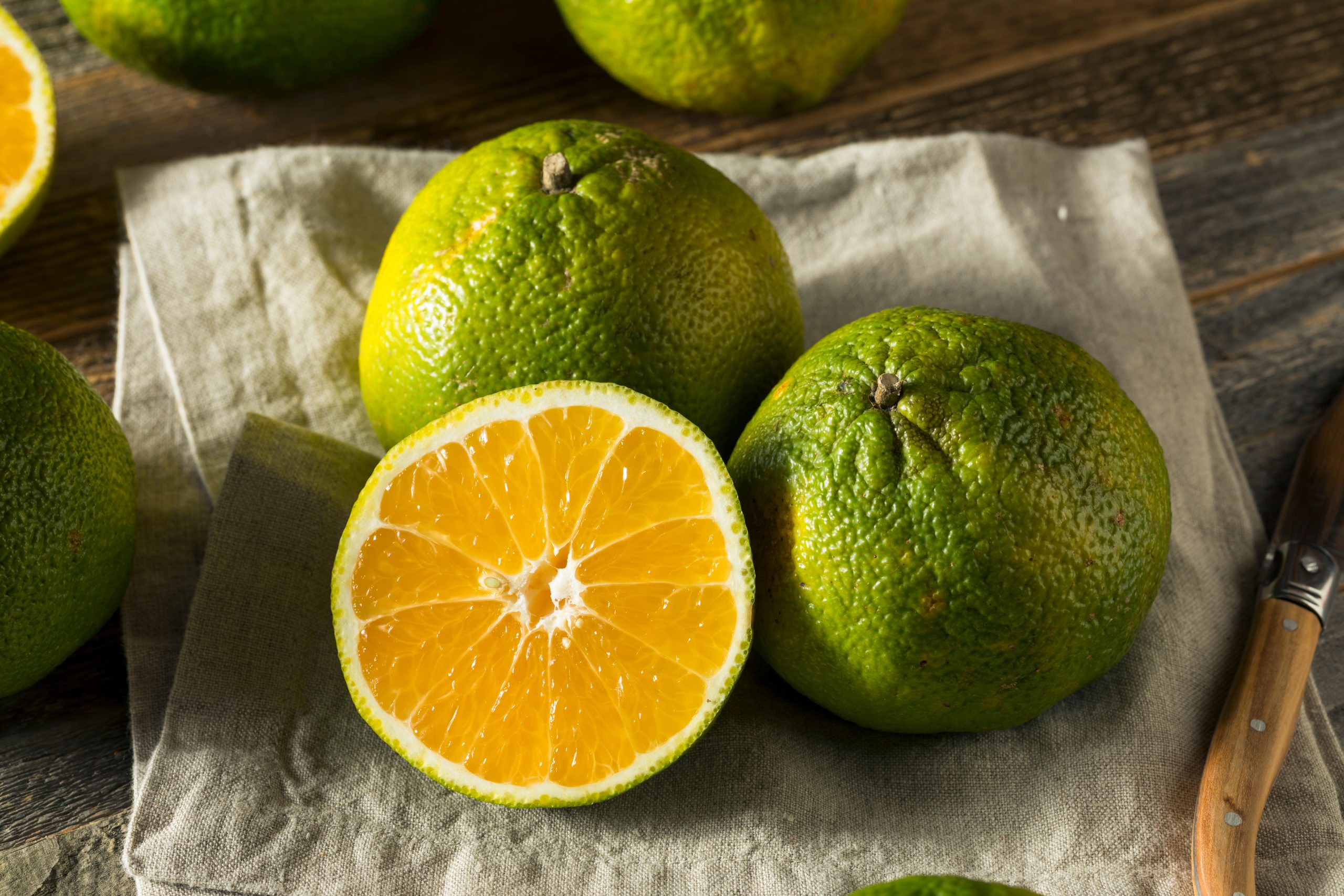An Ugli fruit is a type of citrus fruit named after its somewhat unappealing appearance. Don’t judge a book by its cover; although it might look a little funky, the Ugli fruit’s sweet and tangy flavors will definitely surprise you.
Table of Contents
What is an Ugli Fruit?
Ugli fruits (Citrus reticulata x paradisi) are odd-looking citrus fruits native to Jamaica. They’re also known as uniq fruit and are believed to be a hybrid of the grapefruit, the Seville orange, and the tangerine families.
They can range from 4 to 6 inches in diameter, and their color can vary from green to greenish-yellow, yellow, and even orange. The flesh will always be bright orange.
Its leathery, rough, and semi-thick peel is usually covered in bumps, wrinkles, and scars. This odd, weathered appearance is where the fruit’s name originates from.
This Jamaican tangelo has a sweet, tangy flavor and juicy flesh, which seems shocking after seeing its skin. It’s a very juicy fruit that tastes like a cross between a mandarin and a grapefruit, sweet and tart, with subtle hints of bitterness.
The History of Ugli Fruit
Ugli fruit was originally found growing wild in Jamaica around 80 years ago, in a pasture close to Brown’s Town in St. Ann’s Parish, Jamaica.
G.G.R. Sharp found the variety and planted seeds for its commercial cultivation on his Trout Hall estate. The Sharp family founded Cabel Hall Citrus Limited to sell Ugli fruits, and it was through this business that the fruits were first exported in the 1930s. It was transported by cargo ships to the United States and South America, where it quickly gained fame.
The variety was grown and studied outside of Jamaica in Florida and California in the 1950s. Unfortunately, many of these test trees were cut down, leaving only a small population of the fruit for cultivation in backyard gardens.
Most Ugli fruit is grown in Jamaica and exported to Europe, Canada, and the US, where it is offered in specialty stores and some supermarkets.
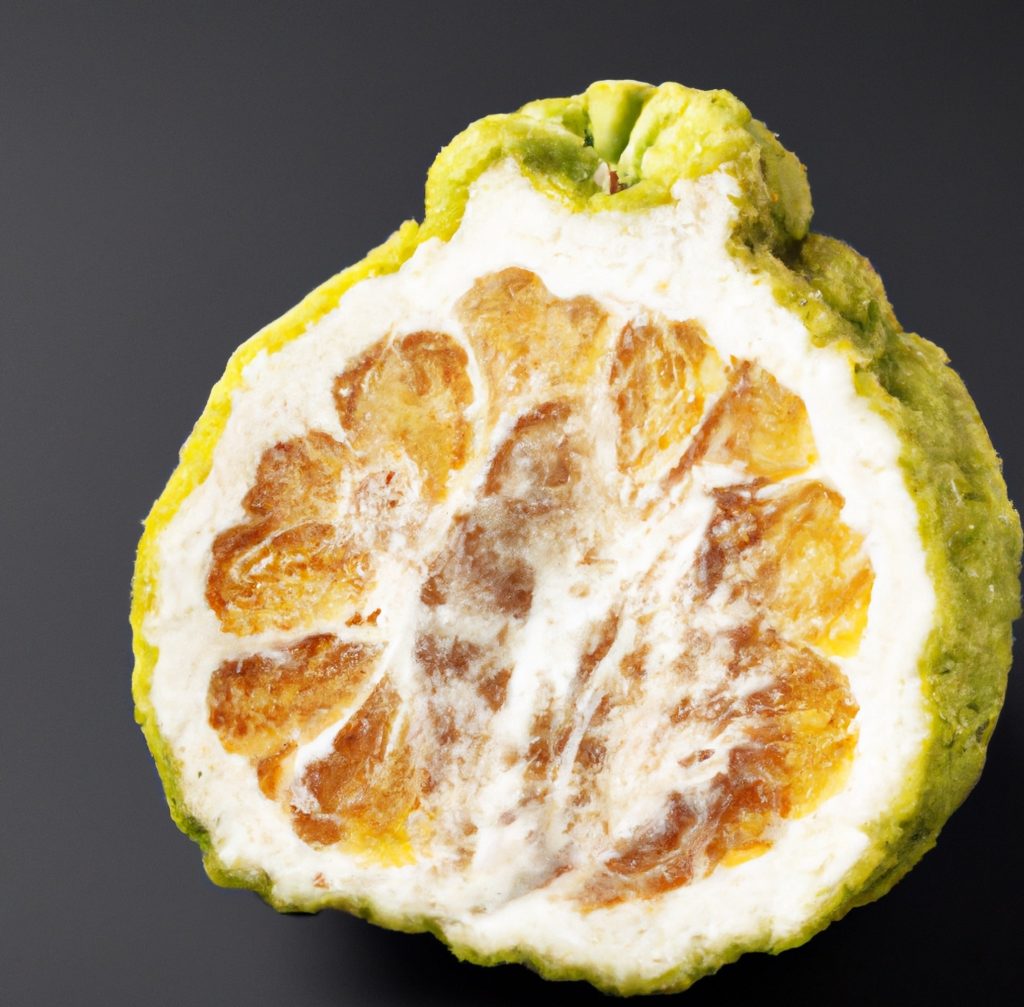
What Does an Ugli Fruit Taste Like?
Ugli fruits have a sweet and tangy flavor, with fruity notes of oranges, pineapple, and grapefruits. They’re very aromatic fruits, similar to citron, with a light, lemon-like fragrance. It has a slightly sweeter and less acidic taste than a grapefruit but a more bitter taste than an orange.
Ugli fruits can make teas, marmalades, smoothies, ice cream, and more when cooked. The texture softens, and the flavor becomes more mellow, removing some bitterness. The taste can be enhanced by adding sugar or any other spices.
How to Tell When Ugli Fruit is Ripe
Here’s what you need to look for when hunting down the perfect Ugli fruit:
| Size | Many Ugli fruits will be substantial in size. However, although they can grow to be quite large, the more modest-sized fruit is typically superior and tastier. |
| Color | The fruits have green, yellow, and orange hues that are variegated, and as they ripen, they take on deeper yellow-orange tones while occasionally keeping green spots. It’s essential to observe that green fruit does not necessarily mean it is unripe. |
| Firmness | Make sure they’re firm to the touch, although the fruit should give a little when pushed. Avoid any that have lots of soft spots or feel mushy. That means they’ve gone bad. |
| Soft Spots | Look for soft spots that are delicate or earthy in color and softly press those with your thumb. The fruit may be harmed if it has soft areas. |
What’s the Difference Between Ugli Fruit and Grapefruit?
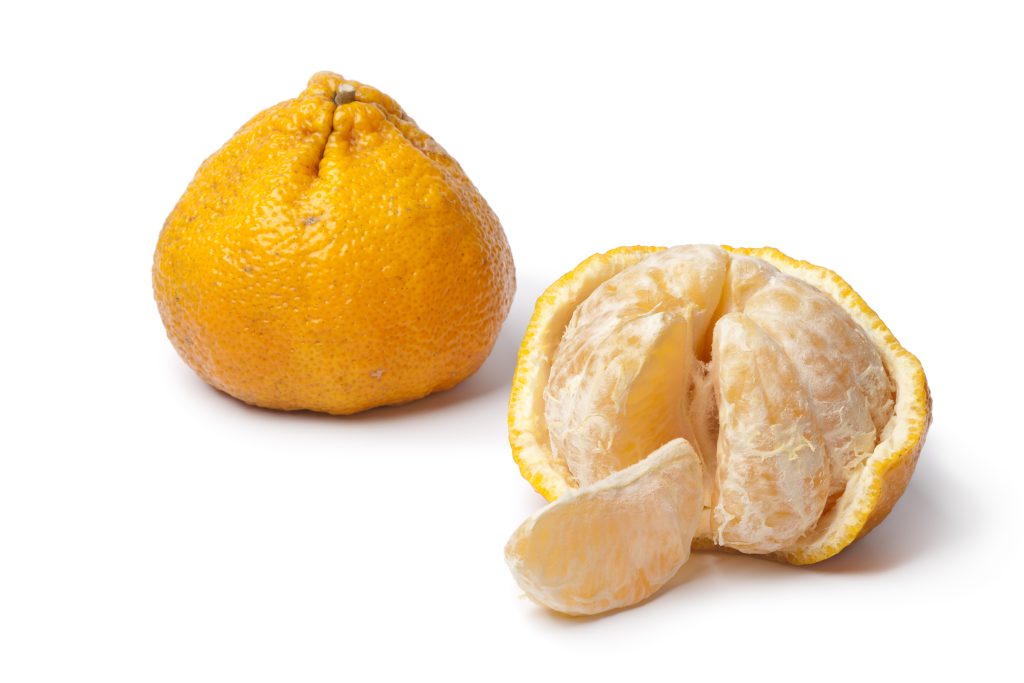
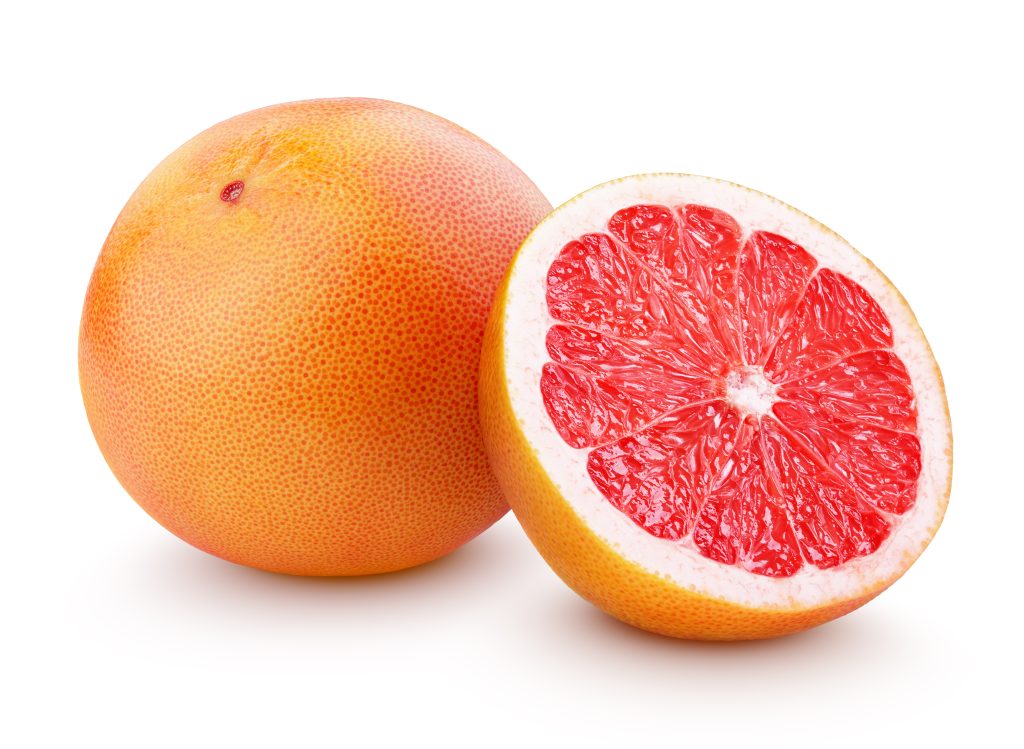
Ugli fruits and Grapefruits are similar in some aspects, both of them being citrus fruits. However, there are some distinct differences that set them apart from one another.
| Shape | They’re both round, although Ugli fruits have more irregular shapes. |
| Color | Ugli fruits are typically orange-yellow, whereas grapefruits are pink, red, or white. The insides of white grapefruits and Ugli fruits are similar, being a creamy yellow color, but the insides of pink grapefruits are pink. |
| Taste and Texture | Both grapefruits and Ugli fruits are succulent, juicy, sweet, and tangy. |
| Nutrients | These fruits are rich in vitamin C and antioxidants, so they’re perfect for supporting our body’s health. |
Cooking with Ugli Fruit
Despite having fewer seeds than oranges and grapefruits, the fruit must be seeded before consumption. To do this, you have to peel it like you would a tangerine and separate the segments.
The segments can be eaten one by one, and normally there aren’t many seeds, so you don’t have to worry too much about spending too much time getting rid of them. If you’d rather, you can cut an Ugli fruit that hasn’t been peeled in half and eat it with a spoon like a grapefruit.
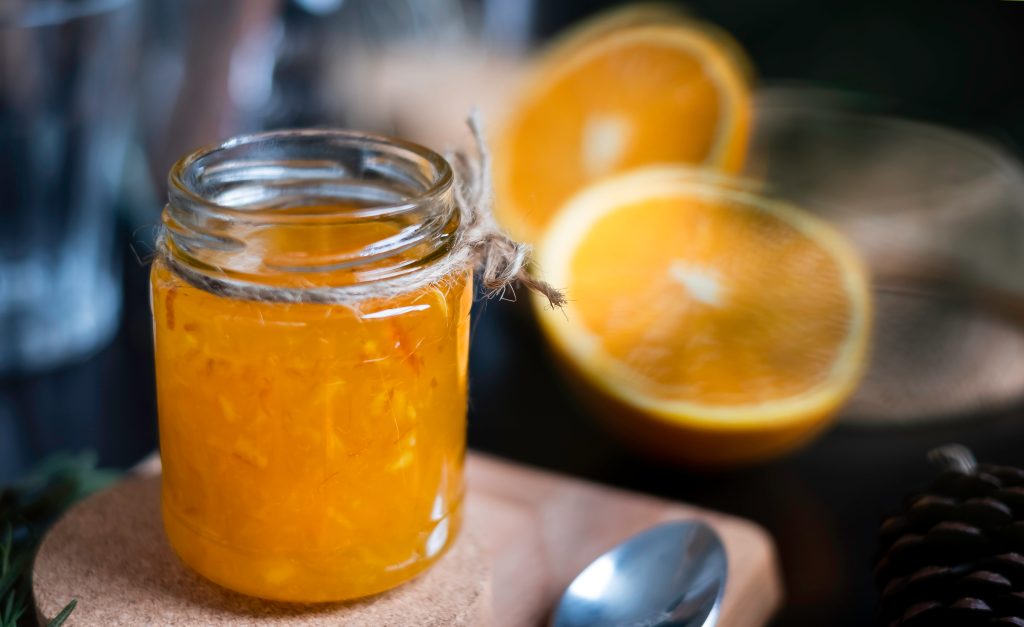
Ugli fruit can be eaten on its own or added to other dishes. Here are a few of our favorite Ugli, but definitely not ugly, recipes:
Ugli Fruit Marmalade Recipe: Making this delicious marmalade isn’t hard, and it can stay in the fridge for a while, so it’s worth making it. Only a jar, sugar, Ugli fruit, and its zest are needed. Perfect for some tang on your toast.
The Ugli-est Tapa Ever Made: A simple pintxo/tapa with anchovies, Ugli fruit, bread, and avocado. Full of healthy fats and vitamins, this dish is great if you want to try something different. It’s perfect for parties or even if you want a snack.
Ugli Fruit Smoothie: Smoothies are the perfect refreshment for summertime and are very easy and quick to make. This Ugli fruit smoothie will get you your daily dose of vitamin C and quench your thirst with its tart, tangy flavor.
Lamb Chops with Rosemary, Ugli Fruit, and Rice Recipe: Not everything Ugli fruit is added to is sweet! You can add Ugli fruit juice to the beef stock and also add its segments to the lamb when it’s cooked. The Ugli fruit is a great addition to this dish, giving it more flavor.
How to Store Ugli Fruit
Eat Ugli fruit within five days of buying them, and make sure to keep them at room temperature. Your ugli fruits can be kept for up to 14 days in the refrigerator for extended storage.
Check the fruit every day to ensure it doesn’t become sour. Look for any developing weak points and press your fingertip into them to see if the skin breaks. In the unlikely event that the rind splits, the fruit may already be spoiled and overripe.
Nutritional Benefits of Ugli Fruit
Vitamin C, an antioxidant that strengthens the immune system, lessens inflammation and increases collagen formation in the skin, is abundant in ugli fruit. The fruits also contain modest amounts of calcium, potassium, and folate and are rich in fiber, which helps to stimulate and cleanse the digestive system. These are a couple of Ugli fruit’s health benefits:
| Manages Cholesterol Levels | Keeping our cholesterol levels healthy means reducing the dangers of coronary illnesses and strokes. |
| Keeps Our Skin Glowing and Fresh | The uniq fruit contains many cancer-preventive catechins and flavanols. Because of this, it can help your skin recover from various problems and improve its appearance. |
| Promotes Weight Loss | Ugly fruit is a simple choice for those trying to get in shape, along with a healthy eating regimen and exercise routine, because it has a low carbohydrate content for each serving and contains no starches or fat. Another critical factor in reducing weight is the fruit’s high fiber content. |
| Aids in Vision Improvement | Vitamin A, which is abundant in the ugli fruit, has been shown to reduce oxidative pressure in the retina, which is excellent for enhancing visual perception. This organic product’s extraordinary supplements could impede the progression of severe degeneration. |
| Promotes Healthy Bones and Blood Circulation | Bone mineral density can benefit from various nutrients in Jamaican ugli fruit. Additionally, it can aid in the body’s creation of red blood cells, preventing anemia. |
Where to Purchase Ugli Fruit
The fruit can be located and bought in the US, Canada, and Europe, particularly in the largest supermarket chains, and more rarely from wholesale and fruit market locations. Since the fruit is typically available from November to May, that is the time of year when you are most likely to locate one to sample and eat.

